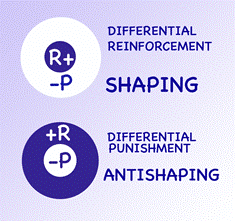 Shaping is the use of positive reinforcement to arbitrarily strengthen a behavior. The process includes positive reinforcement for a specific behavior which, when it emerges, is called an operant. The term is used to describe a positive reinforcement procedure. The problem is that unless an absence of reinforcement for all “other” behaviors occurs, a discrete operant cannot form. To accurately describe the process one must include the effects of negative punishment for “other” behaviors. However, that is never done. The effects of negative punishment are assumed but not stated.
Shaping is the use of positive reinforcement to arbitrarily strengthen a behavior. The process includes positive reinforcement for a specific behavior which, when it emerges, is called an operant. The term is used to describe a positive reinforcement procedure. The problem is that unless an absence of reinforcement for all “other” behaviors occurs, a discrete operant cannot form. To accurately describe the process one must include the effects of negative punishment for “other” behaviors. However, that is never done. The effects of negative punishment are assumed but not stated.
By contrast, DRO is shorthand for differential reinforcement of other behavior. It is the process of applying negative punishment to a single behavior and positive reinforcement for any other behavior. This is the logical opposite of shaping. To be accurate, for whatever shaping may be, DRO is anti-shaping – a symmetrical process applying opposite behavioral effects. The relationship of a single behavior receiving one behavioral polarity and all other behaviors receiving the other behavioral polarity is identical. The language of behavior analysis does not reflect this.
The question is simple. If shaping is a positive reinforcement procedure, DRO is a punishment procedure that would be accurately described as differential punishment of an operant and should be abbreviated as DPO. As shaping does not mention the use of negative punishment to form an operant, DPO should not mention positive reinforcement for “other” behavior.
In the practical application of behavior analytic principles, called applied behavior analysis (ABA) using the word punishment to describe a recommended procedure is not done. Negative punishment, the removal of reinforcement that causes a behavior to decline or stop, is erroneously called extinction. The terms negative reinforcement and extinction are synonyms but not treated as such. To illustrate this fact, I offer two definitions from the glossary of a very fine book on behavior analysis, called Learning by A. Charles Catania – a pillar of behavior analytic thought.
“A stimulus is a positive punisher if it’s presentation reduces the likelihood of responses that produce it or a negative punisher if its removal reduces the likelihood of responses that terminate it.”
Also from Learning:
“Extinction: In operant behavior, discontinuing the reinforcement of a response (or the reduction in responding that follows this operation).
The two terms do, indeed, have the same meaning. They describe the weakening of an operant via lack of reinforcement. Apparently behavior analysts need two words to describe the same effect. The problem is that the term positive reinforcement needs a symmetrical opposite using the same logical choice of words – negative punishment. We do not see negative reinforcement complimented by a word that does not fit the format of punishment vs. reinforcement and positive vs. negative. If you ask why behavior analysts do not acknowledge the effect of negative punishment in shaping, add the term reinforcement to anti-shaping and never use the term punishment as a logical description of a behavioral phenomenon, I can only suggest you consider bias as the best answer. This quote regarding B.F. Skinner from the Association for Behavior Analysis, a professional organization he founded, says it all.
“Throughout his career, Skinner opposed the use of all forms of punishment; he advocated positive ways of changing behavior. “
If the creator of a sub-discipline of science infuses his work with ideological biases, would that be likely to infuse the discipline with language that was ideological in nature? Yup.

Really need to learn how to STOP barking at people walking down the sidewalk. She is behind a 6ft metal fence, so unless someone approaches the gate with bad intent I need her to just “shut up”.
Is there a fast and effective way to get this done.
Thank-you in advance for any help you may be able to provide.
e.jones
Oh sorry my dog is a 3 year old Rottweiler. She is smart but stuborn. She is also a she. My last Rottweiler was a he and we both participated in his very extensive obedience training
Unfortunately just after I purchased her my son took his life and I found him. He was 39. So, she has the basics down but
since I was do erratic with her discipline, she only about 1/2 listens to me. Can you help me with this situation?
Thank-you so much for whatever you can point me in the direction to her being a better dog but teaching me how to be a better dog parent.